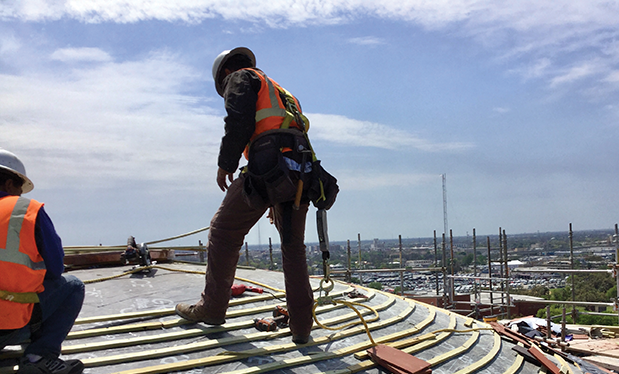On Feb. 26, FM Global updated its Property Loss Prevention Data Sheet 1-28, “Wind Design,” to reflect changes in its wind load determination methodology. FM 1-28 is intended to provide designers with general guidance for highly protected, FM Global-insured buildings. Following is an overview of the roofing-specific changes.
FM 1-28’s changes
FM 1-28 is a 100-page document divided into five primary sections: scope, loss prevention recommendations, support for recommendations, references and appendixes. Wind speed maps for the U.S., including detailed maps for Hawaii, are provided in Appendix C. Changes from FM 1-28’s previous edition, released in October 2015, are denoted in red. Also, Section 1.1-Changes summarizes significant changes.
The most notable change is the uplift design pressure tables that appeared in the previous edition have been removed. Now, use of the Ratings Calculator provided in FM Approvals’ RoofNav application (www.roofnav.com) is recommended. The pressure equations and various pressure coefficients used in the Ratings Calculator are described in FM 1-28’s Section 3.
FM 1-28 now uses pressure coefficients and zone dimensions based on ASCE 7-16, “Minimum Design Loads and Associated Criteria for Buildings and Other Structures.” However, FM 1-28 does not use ASCE 7-16’s wind maps and basic wind speeds. Instead, FM 1-28 uses wind maps and basic wind speeds based on ASCE 7-05.
Also, FM 1-28 and RoofNav’s Ratings Calculator base their calculations on allowable stress design; ASCE 7-05 also is based on allowable stress design. ASCE 7-10 and ASCE 7-16 are based on ultimate strength design.
New guidance has been added for rooftop-mounted equipment. FM 1-28 recommends a professional structural engineer design attachment and resistance to overturning moment for large rooftop-mounted equipment. Separate equations based on ASCE 7-10 and ASCE 7-16 are provided for determining horizontal and vertical wind forces. For new installations of rooftop piping or conduit, an engineer also should verify adequate securement to the roof deck or structure. Appurtenances (intake and exhaust hoods, cowlings) should be secured according to guidelines in FEMA 549, “Attachment of Rooftop Equipment in High-Wind Regions.”
Comparing results
To analyze the significance and magnitude of the changes to FM 1-28, NRCA has performed a series of calculations comparing the results from the 2015 version with the new version and RoofNav’s Ratings Calculator. The results of example design wind load determinations for hypothetical 60- and 150-foot buildings located in Chicago are shown in the figure.
For the 60-foot-tall building, the new procedures result in significant increases in design wind loads compared with FM 1-28’s 2015 version. For this example, a Class 90 uplift rating now is recommended when previously only a Class 60 uplift rating would have been necessary.
For the 150-foot-tall building, there are no differences in the design wind loads. This is because there are minimal changes in FM 1-28 applicable to most high-rise buildings.
Comparing the results using FM’s new procedures with ASCE 7-16, which is referenced in the International Building Code,® 2018 Edition, FM Global’s new procedures typically result in higher design wind loads than those of ASCE 7-16. Converting ASCE 7-16’s ultimate design wind loads to allowable stress design allows for direct comparison of FM’s new procedure with IBC 2018’s requirements. For both the 60- and 150-foot-tall building examples, FM Global’s new procedures resulted in higher design wind loads than are required by IBC 2018.
NRCA’s recommendations
If you are working on roofing projects at FM Global-insured buildings, I encourage you to be aware of FM 1-28, its changes and the effects these changes may have on roof assembly designs.
IBC 2018 (and its previous editions) requires design wind loads be provided in projects’ construction documents. For FM Global-insured buildings, if FM 1-28 results in design wind loads higher than those required by the applicable code, the designer should clearly delineate these in the project’s construction documents.
FM Global has indicated it intends the new version of FM 1-28 to be effective immediately upon publication. If you have previously bid on or are under contract for roofing projects on FM Global-insured buildings, you should contact your building owner, who can coordinate with his or her assigned FM Global field engineer, to determine whether any changes to the project’s roof assembly design are necessary. You also can contact NRCA’s Technical Services Department for further guidance.
FM 1-28 and other Loss Prevention Data Sheets are available from www.fmglobaldatasheets.com.

Mark S. Graham is NRCA's vice president of technical services.
@MarkGrahamNRCA
This column is part of Research + Tech. Click here to read additional stories from this section.



